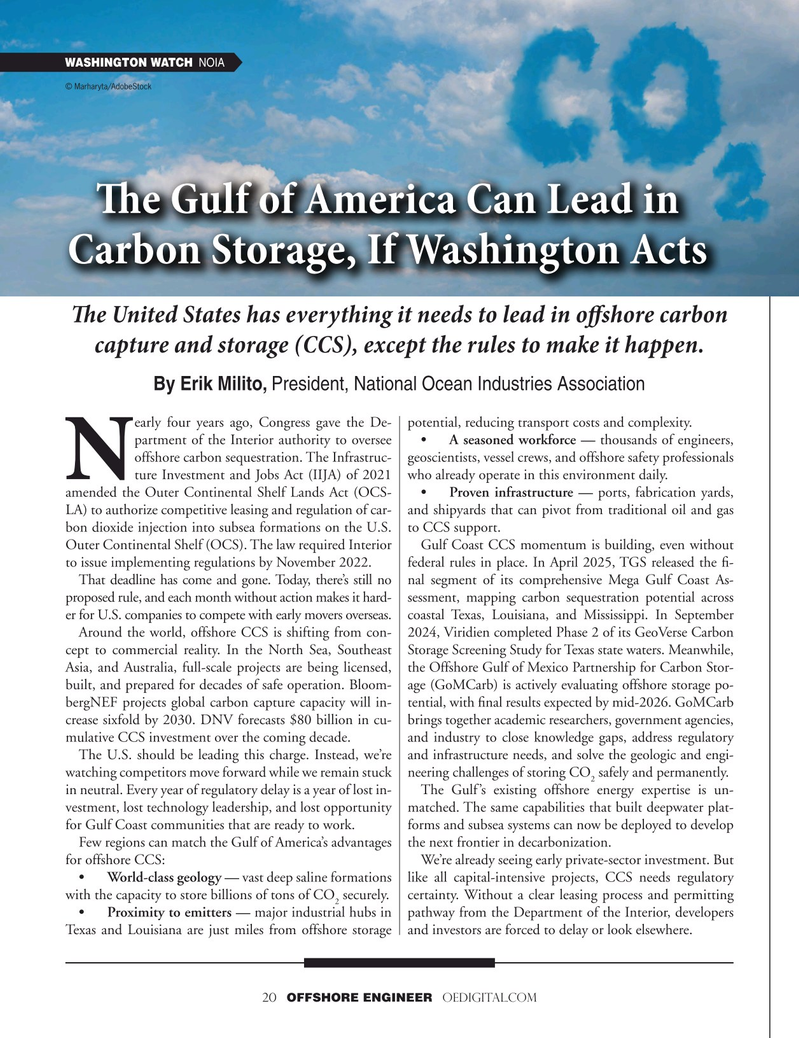
Page 20: of Offshore Engineer Magazine (Jul/Aug 2025)
Read this page in Pdf, Flash or Html5 edition of Jul/Aug 2025 Offshore Engineer Magazine
WASHINGTON WATCH NOIA © Marharyta/AdobeStock
Te Gulf of America Can Lead in
Carbon Storage, If Washington Acts
Te United States has everything it needs to lead in ofshore carbon capture and storage (CCS), except the rules to make it happen.
By Erik Milito, President, National Ocean Industries Association early four years ago, Congress gave the De- potential, reducing transport costs and complexity.
partment of the Interior authority to oversee • A seasoned workforce — thousands of engineers, offshore carbon sequestration. The Infrastruc- geoscientists, vessel crews, and offshore safety professionals ture Investment and Jobs Act (IIJA) of 2021 who already operate in this environment daily.
N amended the Outer Continental Shelf Lands Act (OCS- • Proven infrastructure — ports, fabrication yards,
LA) to authorize competitive leasing and regulation of car- and shipyards that can pivot from traditional oil and gas bon dioxide injection into subsea formations on the U.S. to CCS support.
Outer Continental Shelf (OCS). The law required Interior Gulf Coast CCS momentum is building, even without to issue implementing regulations by November 2022. federal rules in place. In April 2025, TGS released the f-
That deadline has come and gone. Today, there’s still no nal segment of its comprehensive Mega Gulf Coast As- proposed rule, and each month without action makes it hard- sessment, mapping carbon sequestration potential across er for U.S. companies to compete with early movers overseas. coastal Texas, Louisiana, and Mississippi. In September
Around the world, offshore CCS is shifting from con- 2024, Viridien completed Phase 2 of its GeoVerse Carbon cept to commercial reality. In the North Sea, Southeast Storage Screening Study for Texas state waters. Meanwhile,
Asia, and Australia, full-scale projects are being licensed, the Offshore Gulf of Mexico Partnership for Carbon Stor- built, and prepared for decades of safe operation. Bloom- age (GoMCarb) is actively evaluating offshore storage po- bergNEF projects global carbon capture capacity will in- tential, with fnal results expected by mid-2026. GoMCarb crease sixfold by 2030. DNV forecasts $80 billion in cu- brings together academic researchers, government agencies, mulative CCS investment over the coming decade. and industry to close knowledge gaps, address regulatory
The U.S. should be leading this charge. Instead, we’re and infrastructure needs, and solve the geologic and engi- watching competitors move forward while we remain stuck neering challenges of storing CO safely and permanently.
2 in neutral. Every year of regulatory delay is a year of lost in- The Gulf’s existing offshore energy expertise is un- vestment, lost technology leadership, and lost opportunity matched. The same capabilities that built deepwater plat- for Gulf Coast communities that are ready to work. forms and subsea systems can now be deployed to develop
Few regions can match the Gulf of America’s advantages the next frontier in decarbonization.
for offshore CCS: We’re already seeing early private-sector investment. But • World-class geology — vast deep saline formations like all capital-intensive projects, CCS needs regulatory with the capacity to store billions of tons of CO securely. certainty. Without a clear leasing process and permitting 2 • Proximity to emitters — major industrial hubs in pathway from the Department of the Interior, developers
Texas and Louisiana are just miles from offshore storage and investors are forced to delay or look elsewhere.
20 OFFSHORE ENGINEER OEDIGITAL.COM

 19
19

 21
21